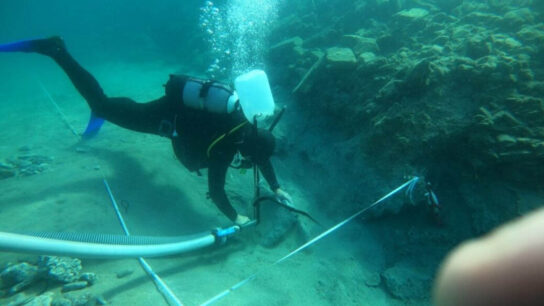Ancient Roman Mosaic from Theodoric the Great’s Villa Discovered near Verona, Italy
A section of the ancient Roman mosaic flooring from the 5th century AD villa of Ostrogoth king Theodoric the Great has been discovered near the northern Italian city of Verona.
The mosaic was found during digging to replace gas pipes at Montorio outside Verona. There is no direct evidence, but given the extent and wealth of finds, it is reasonable to think that it was a villa referring to the emperor Theodoric or the highest-ranking prime minister of his collaborators.
If it wasn’t Theodoric’s villa, it must have belonged to someone of enormous wealth who was very close to him.

“Bits of mosaic, thermal facilities, and residential complexes have been emerging in a scattered way at Montorio over the past decades and it is now time to systematize them,” said Verona cultural heritage superintendent Vincenzo Tinè.
Theodoric was not technically a Roman emperor. He was three different varieties of the king, though, starting in 475 A.D. as King of the Ostrogoths, then adding King of Italy in 493 and of the Visigoths in 511.
By the time of his death in 526, Though Theodoric himself only used the title ‘king’ (rex), some scholars characterize him as a Western Roman Emperor in all but name, since he ruled large parts of the former Western Roman Empire, had received the former Western imperial regalia from Constantinople in 497 and was referred to by the title Augustus by some of his subjects.
Theodoric reigned over most of what had been the Western Roman Empire. He spent his childhood as a noble hostage at the imperial court in Constantinople and was educated there in the Eastern Roman tradition.
As ruler of the combined Gothic realms, Theodoric controlled an empire stretching from the Atlantic Ocean to the Adriatic Sea.

Theodoric promoted the rebuilding of Roman cities and the preservation of ancient monuments in Italy.
He instituted a vast program of reconstruction of Roman cities and infrastructure, restoring ancient aqueducts, baths, churches, the Aurelian walls of Rome, and the defensive walls of myriad other cities in Italy.
He threw in a few new palaces for himself while he was at it, most famously in his capital of Ravenna, but also other northern Italian cities like Verona.
The mosaic will remain in place. It will be cleaned and documented in detail before being reburied.
Some residents have proposed covering it with plexiglass so that the mosaic is still visible, something that has already been done in the historic center of Verona, but this mosaic is in a terribly awkward position, trapped under networks of old pipes surrounded by houses so is unfortunately not a good candidate for display.




